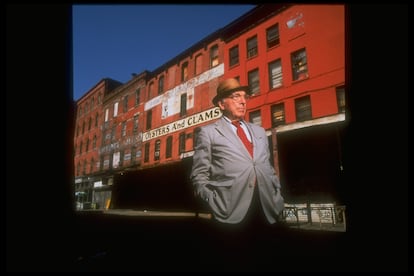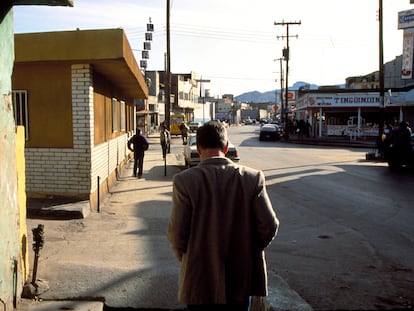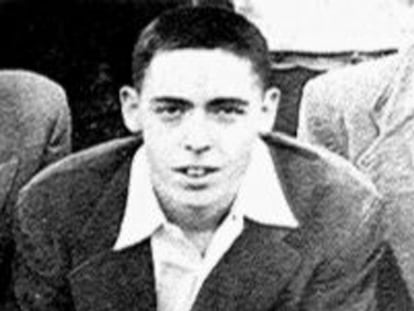Joseph Mitchell: A student of people
The legendary writer from ‘The New Yorker’ spent a career reporting on the characters in and around his adopted city

Joseph Mitchell had a mythical aura in the golden age of American journalism. His watchful eye and depressive nature helped capture the melancholy of New York City.
Throughout the 1940s, the elegant chronicler painted a picture of the inhabitants of America’s biggest metropolis, helping to inspire the work of writers such as Truman Capote, Joan Didion and Hunter S. Thompson. A sensitive spirit, he coined an immortal phrase worthy of being carved in both newsrooms and palaces: “Ordinary people are as important as you, whoever you are.”
Mitchell – who passed away in 1996 – spent more than 30 years going to the office of The New Yorker every morning. He would quietly pass through the newsroom, enter his office and lock himself in, with only the sound of his old typewriter to keep him company.
In the 1960s, a couple of compilations of his stories for the highbrow magazine were published in book form: Joe Gould’s Secret, in two instalments.
One of the most famous stories in the collection was titled An Oral History of Our Time. It discussed an eccentric New York bum, who ate ketchup and wrote down everything he heard in the streets, filling thousands of notebooks. But by 1965, Mitchell was hit by a terrible case of writer’s block. In fact, it was so terrible that he never published anything again. His pen stopped moving, his typewriter stopped clicking. His name no longer appeared in the pages of The New Yorker. And, while this left readers disappointed, his legend grew.
Mitchell’s chronicles demonstrate the virtues of a true storyteller, one who elevated the journalistic profile of nobodies and nothingness to art. Rather than glorifying the money, fame and power of the city, he focused his interest – and his flowing prose – on seedy bars, old boarding houses, bearded women, charismatic gypsies, fanatical preachers and bohemians of all kinds. There were no “little people,” Mitchell insisted. Perhaps he said it because, despite his tailored suits and elegant hats, the reserved man – deeply in love with microcosms – never forgot where he came from.
Born on a cotton and tobacco farm in Robeson County, North Carolina, Joseph Mitchell arrived in New York the day after the stock market crashed in 1929, which marked the beginning of the Great Depression. He was just 21. Despite the hard times he witnessed around him, he fell in love with the big city as only a romantic outsider can.
Mitchell honed his passion for writing with a piece of advice that was given to him by his first editor at the now-defunct New York Herald Tribune: to be a good reporter, walk.
That’s what Mitchell did his whole life. Walking, alone, past every block of New York. Looking at the city, listening to it, feeling it; discovering it every day, in a kind of daily addiction that he maintained until the end of his life.
Even years after his death, his observations continue to garner interest. In 2008, 14 years after his passing, a compilation of six major profiles that he wrote between 1944 and 1959 was published: The Bottom of the Harbor. These stories – centered around the New York Port – define the author’s fascination for New York’s people, traditions, atmospheres… and how they are tied to the wider world.
From veteran waiters at the moldy hotels, to drunk, wandering sailors, Mitchell zooms in on those who lived the larger parts of their lives in the vicinity of hundreds of ships that rotted at the bottom of the port. He listens to an immigrant from Brazil, who recalls how, every spring, bodies emerge from the dirty water; he transcribes the words of a sad old New Englander, whose family has been fishing for three hundred years.
Mitchell was a profiler who never judged or rushed – he let everyone have their say.
He also drifted away from Manhattan, although he didn’t get very far. In one story from Sandy Ground – an almost empty town in Staten Island – he describes the oyster boom that once flanked the coasts of Brookly and Queens, before the pollution of the Hudson River sank the business. He walks through the ruined town, witnessing a shadow of what it once was. He describes the empty porches, the faint children’s voices.
In Sandy Grounds, he would spend a whole day with Mr. Hunter – an old man, who guides Mitchell to a weed-filled cemetery to show him a tombstone that he has reserved: it only awaits the date of his death. The reporter snatches a phrase from Mr. Hunter: “Every morning, the world begins anew.”
The chronicler was able to begin anew for decades and decades, as he offered up doses of literary reality from the ground. But even after he stopped publishing, he didn’t stop being devoted to capturing the ordinary. His secrets were the following: work hard, publish little and never stop walking.
Sign up for our weekly newsletter to get more English-language news coverage from EL PAÍS USA Edition
Tu suscripción se está usando en otro dispositivo
¿Quieres añadir otro usuario a tu suscripción?
Si continúas leyendo en este dispositivo, no se podrá leer en el otro.
FlechaTu suscripción se está usando en otro dispositivo y solo puedes acceder a EL PAÍS desde un dispositivo a la vez.
Si quieres compartir tu cuenta, cambia tu suscripción a la modalidad Premium, así podrás añadir otro usuario. Cada uno accederá con su propia cuenta de email, lo que os permitirá personalizar vuestra experiencia en EL PAÍS.
¿Tienes una suscripción de empresa? Accede aquí para contratar más cuentas.
En el caso de no saber quién está usando tu cuenta, te recomendamos cambiar tu contraseña aquí.
Si decides continuar compartiendo tu cuenta, este mensaje se mostrará en tu dispositivo y en el de la otra persona que está usando tu cuenta de forma indefinida, afectando a tu experiencia de lectura. Puedes consultar aquí los términos y condiciones de la suscripción digital.
More information
Archived In
Últimas noticias
Most viewed
- Reinhard Genzel, Nobel laureate in physics: ‘One-minute videos will never give you the truth’
- Oona Chaplin: ‘I told James Cameron that I was living in a treehouse and starting a permaculture project with a friend’
- Pablo Escobar’s hippos: A serious environmental problem, 40 years on
- Why we lost the habit of sleeping in two segments and how that changed our sense of time
- Chevy Chase, the beloved comedian who was a monster off camera: ‘Not everyone hated him, just the people who’ve worked with him’










































